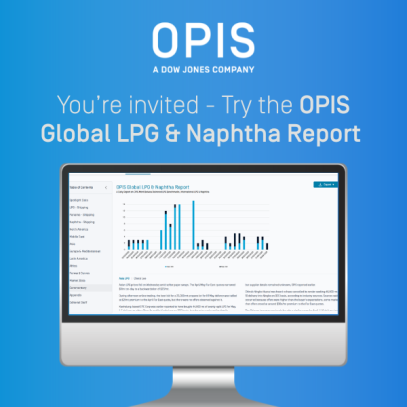Partner Article, by OPIS, A Dow Jones Company
Europe LPG Market Eyes Waning Petchems as Geopolitical Risks Climb in 2025
As the northwest European liquefied petroleum gas (LPG) market moves further into 2025, further rationalization in the petrochemical sector is expected, while U.S. supply is set to increase its share in the European import market.
Early signs of rationalization in the petrochemical sector emerged in the first quarter of the year. In the first days of March, Austria’s OMV AG and Abu Dhabi National Oil Co (ADNOC) signed a binding agreement to merge their polyolefins businesses, creating Borouge Group International, a $60 billion company. As part of the deal, Borouge Group will acquire Canada-based NOVA Chemicals.
Shell has announced it intends to explore a potential sale of its chemical assets in Europe and in the U.S., to refocus the company’s business on its most profitable operations. And finally, in the Netherlands, LyondellBasell and Covestro have jointly decided to permanently close the propylene oxide styrene and monomer (POSM) production unit PO11 at the Maasvlakte plant.
The plant which has a production capacity of 680,000 metric tons/year of styrene and 313,000 mt/year of propylene oxide, was idled last year due to high energy costs and weak market demand.
Consumption of LPG across all sectors in Europe is expected to dip to 31.9 million mt in 2025, down from 33.18 million mt in 2024, according to the LPG Outlook data from Chemical Market Analytics (CMA) by OPIS, a Dow Jones company.
The petrochemicals industry is expected to play a major role in that decline with consumption for chemicals dropping to 12.72 million mt from 15.38 million in 2024, data from the report added.
Marginal gains are anticipated in the retail/wholesale sectors, namely in the residential, commercial, industrial, agricultural and refinery markets. However, declines are anticipated in the autogas industry with consumption expected to dip to 3.66 million mt from 4.04 million mt in 2024, the report showed.
While chemical demand for Europe as a whole is expected to decline in 2025, central Europe breaks that trend. Chemical consumption in central Europe is forecast to reach 1.06 million mt in 2025, up from 1.048 million mt in 2024.
Central Europe does follow a similar pattern to Europe with regards to the retail/wholesale sector with gains noted in demand for residential, commercial and industrial markets. Autogas demand is stated to dip to 2.03 million mt from 2.4 million in 2024.
And in western Europe, chemical demand is stated to drop to 11.67 million mt in 2025, from 14.53 million mt in 2024, the report showed. Retail/wholesale consumption is expected to grow in all sectors including autogas, albeit marginal.
U.S. supply steps higher
For the major feedstock LPG, sourcing increased supply from the North Sea is highly unlikely given the maturity of existing offshore fields. Instead, any new supply in 2025 is likely to depend on expansion of U.S. export terminals.
However, this may not come to pass given that U.S. export terminals had maxed out their capacity by the middle of 2024, sending spot fees soaring. In the U.S. Gulf Coast, Enterprise Products Partners expects its 195,000 b/d Fractionator 14 at Mont Belvieu to be operational in 2025, while to alleviate constraints at terminals, other projects are on track to expected to expand capacity.
Enterprise Products Partners is expecting the first phase of its Neches River NGL Export terminal to be operational in 2025 as well as the final phase of its Morgan's Point Terminal Flex expansion. Targa Resources is planning a debottlenecking of its existing terminaling facilities during 2025.
LPG exports from the U.S. to the Mediterranean stepped higher again in 2024, while deliveries to northwest Europe softened, widening the gap between itself and the Mediterranean as the main destination hubs for U.S. supply, OPIS analysis of data from analytics firm Vortexa showed.
Northwest Europe has typically been the preferred destination for trans-Atlantic U.S. LPG exports; however, in 2024, the tide shifted with the Mediterranean opening a gap as the largest recipient. Butane and propane exports to the Mediterranean from the U.S. reached 6.01 million metric tons in 2024, up from 5.77 million mt in 2023. U.S. exports to Northwest Europe totaled 5.13 million mt in 2024, down from 5.73 million mt in 2023.
Petrochemical producers were squeezed from several sides at the back end of last year but particularly so in November. Ethylene was long with healthy supply and subdued end-user demand, while LPG feedstock prices came under pressure.
The propane/naphtha spread for November also proved problematic for feedstock buyers as the spread narrowed to just -$32/mt by the end of the month. The propane/naphtha spread had opened in November at -$70/mt. By comparison, a spread of around minus $50/mt would favor the use of naphtha as a steam cracker feedstock, according to OPIS data.
However, in the first quarter of the year, the U.S. has exported 1.77 million mt of propane and butane to Northwest Europe, the strongest quarterly output since the second quarter 2022, Vortexa data showed.
Comparatively, U.S. flows to the Mediterranean have eased to 1.64 million mt, down from 1.74 million mt in the fourth quarter last year.
Geopolitical risks
Geopolitics remains front and centre of every discussion related to trade flows in 2025. President Donald Trump's trade policies of hikes in tariffs on goods coming from Mexico, Canada and China are starting to take effect but are yet to be seen for any potential disruption in the global trading pattern, offering the possibility of a two-tiered market for exports into Asia.
While comparisons will obviously be made to the tariffs implemented by Donald Trump in 2019, the market has changed significantly since then amid surging Chinese LPG demand. In 2018, the U.S. exported 1.17 million mt of propane and butane to China, data from shipping analytics firm Vortexa showed, dropping to 88,500 mt in 2019. But in 2024, the U.S. exported a whopping 16.1 million mt of propane and butane to China.
In a 2025 trade scenario that assumes no U.S. product is exported to China, then even if all Middle East, West Africa, Canadian flows were re-directed to China, the amount required would still be short, according to consultancy NGL Strategy, as the U.S.-China flow remains essential.
A more immediate concern comes from the U.S. government's recently announced proposal to impose fees on Chinese-built vessels and shipowners with newbuild orders at Chinese yards calling at U.S. ports. These possibilities would include a charge up of to $1.5 million to enter U.S. ports for Chinese-built vessels. Alternatively, the U.S. would charge $1,000 per net ton of a vessel's cargo capacity.
Non-Chinese firms operating Chinese-built ships would pay up to $1.5 million per port entry and those with greater than 50% Chinese-built fleets would pay $1 million per vessel entry regardless of origin. The fee would fall to $750,000 if the Chinese fleet percentage was between 25% and 50% and to $500,000 if under 25%.
The tariff could bring about an increase in ton-mileage for the very large gas carrier (VLGC) fleet, bringing extra costs to shipping and putting more pressure on Chinese buyers who are already operating with fine margins at some of their PDH and steam cracking units.
In Europe, the ban on Russian propane and propane-mix products introduced in late December 2024 appears to have had minimal effect on countries that were previously more reliant on Russian LPG flows.
Poland has been a major recipient of Russian LPG over the years, not just via sea but also rail. Ukraine’s A-95 Consulting group said Russia exports around 1 million mt/year of propane and butane via rail links to Poland.
In the Black Sea, Turkey became the largest supplier of LPG to Ukraine in February, according to A-95 Consulting data. In February, total LPG imports to Ukraine totaled 50,100 mt, up by 8% from January, but 16% less than in the same period in 2024.
The largest decrease in supply was from Romania which fell by 55% to 11,500 mt. Romanian supply to Ukraine was replaced by supply from Turkey, equivalent to 15,800 mt, while some volumes also originated in Egypt. In February, 58% of the total LPG volume to Ukraine was shipped from Turkey – from the Likitgaz Dagitim terminal and via Turkish Aygaz, the data showed.
Shipping
From a shipping point of view, terminal constraints in the U.S. Gulf Coast are likely to be the largest concern for the market in 2025, with expansion completions for the second half of the year.
Additional export projects in the U.S. Gulf and west coast of Canada could increase capacity by 40% through to 2028, according to data from shipowner Dorian LPG. In the U.S. Gulf, there are four projects in the pipeline, all based in Texas, that could add a potential 2.27 million mt/month of capacity.
However, coupled with a modest VLGC orderbook in 2025, around 80 VLGCs are due for dry docking this year. As of Mar. 3, one new VLGC has been delivered so far this year with eleven more VLGCs scheduled. That makes 2025 the lowest year for VLGC newbuilding deliveries since 2018, data from shipowner BW LPG showed. Looking further ahead, the fleet growth over the next 18 months represents around 5% of the current fleet, according to BW LPG data, the majority of which can use ammonia as fuel.
The orderbook for 2026 and 2027 sees ammonia capable carrier deliveries skyrocket. In 2026, 23 VLGCs are due for delivery - 18 of which will be ammonia-ready - and in 2027, 46 VLGCs are expected to arrive, 39 of which will be very large ammonia carriers (VLAC), BW LPG said.
There are approximately 137 VLACs and VLECs on order to be delivered from 2025 onwards, although the majority of these are due for delivery in 2027, according to OPIS shipping data. So, while geopolitical sensitivities persist for 2025, with the U.S and China at the center, there are also potential pressure points from production, export and demand.
Gas carrier inefficiencies concerning fuel consumption and distances travelled, plus rising ton-mileage, increasing environmental regulations, alternative fuel and emission costs are all going to be prevalent in 2025.
In Europe, petrochemical players are expected to further consider their position in the market this year. Consolidation remains a fundamental topic in the sector and is certainly one to watch as the year progresses.
-Reporting by Jamie Aldridge, jaldridge@opisnet.com & Dermot McGowan, dmcgowan@opisnet.com


From Mont Belvieu to the World: Navigate Global LPG Markets with Greater Transparency
As LPG exports from the U.S. Gulf Coast surge, the OPIS Global LPG & Naphtha Report provides the transparency you need to navigate evolving markets. Powered by the OPIS Mont Belvieu benchmark, this report integrates freight intelligence and delivery costs to key ports worldwide—helping you make informed decisions with confidence.
Review this report for free to explore market intelligence from OPIS.


